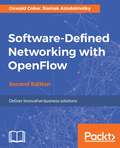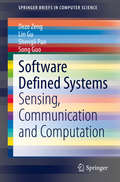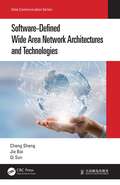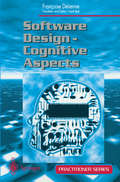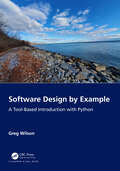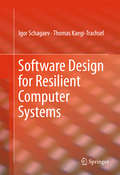- Table View
- List View
Software-Defined Networking for Future Internet Technology: Concepts and Applications
by Kshira Sagar Sahoo Bibhudatta Sahoo Brojo Kishore MishraNetwork infrastructures are growing rapidly to meet the needs of business, but the required repolicing and reconfiguration provide challenges that need to be addressed. The software-defined network (SDN) is the future generation of Internet technology that can help meet these challenges of network management. This book includes quantitative research, case studies, conceptual papers, model papers, review papers, and theoretical backing on SDN. This book investigates areas where SDN can help other emerging technologies deliver more efficient services, such as IoT, industrial IoT, NFV, big data, blockchain, cloud computing, and edge computing. The book demonstrates the many benefits of SDNs, such as reduced costs, ease of deployment and management, better scalability, availability, flexibility and fine-grained control of traffic, and security. The book demonstrates the many benefits of SDN, such as reduced costs, ease of deployment and management, better scalability, availability, flexibility and fine-grained control of traffic, and security. Chapters in the volume address: Design considerations for security issues and detection methods State-of-the-art approaches for mitigating DDos attacks using SDN Big data using Apache Hadoop for processing and analyzing large amounts of data Different tools used for attack simulation Network policies and policy management approaches that are widely used in the context of SDN Dynamic flow tables, or static flow table management A new four-tiered architecture that includes cloud, SDN-controller, and fog computing Architecture for keeping computing resources available near the industrial IoT network through edge computing The impact of SDN as an innovative approach for smart city development More. The book will be a valuable resource for SDN researchers as well as academicians, research scholars, and students in the related areas.
Software Defined Networking with OpenFlow
by Siamak AzodolmolkyA step-by-step, example-based guide which will help you gain hands-on experience with the platforms and debugging tools on OpenFlow.If you are a network engineer, architect, junior researcher or an application developer, this book is ideal for you. You will need to have some level of network experience, knowledge of broad networking concepts, and some familiarity with day- to- day operation of computer networks. Ideally, you should also be familiar with programing scripting/languages (especially Python and Java), and system virtualization.
Software-Defined Networking with OpenFlow - Second Edition
by Siamak Azodolmolky Oswald CokerMaster OpenFlow concepts to improve and make your projects efficient with the help of Software-Defined Networking. About This Book • Master the required platforms and tools to build network applications with OpenFlow • Get to grips with the updated OpenFlow and build robust SDN-based solutions • An end-to-end thorough overview of open-source switches, controllers, and tools Who This Book Is For If you are a network/system administrator or a system engineer and would like to implement OpenFlow concepts and take Software-Defined Networking on your projects to the next level, then this book is for you. If you are aware of broad networking concepts, and are familiar with the day-to-day operation of computer networks, you will find this book very beneficial. What You Will Learn • Explore Software-Defined Networking and activities around SDN/OpenFlow including OpenFlow messages • Hardware and software implementations of OpenFlow switches and experiment with Mininet GUI • Learn about the role of OpenFlow in cloud computing by configuring and setting up the Neutron and Floodlight OpenFlow controller plugins • Simulate and test utilities, and familiarize yourself with OpenFlow soft switches, controllers, virtualization, and orchestration tools • Enhance and build environments for Net App development by installing VM's and tools such as Mininet and Wireshark • Learn about hardware and software switches and get a feel for active open-source projects around SDN and OpenFlow In Detail OpenFlow paves the way for an open, centrally programmable structure, thereby accelerating the effectiveness of Software-Defined Networking. Software-Defined Networking with OpenFlow, Second Edition takes you through the product cycle and gives you an in-depth description of the components and options that are available at each stage. The aim of this book is to help you implement OpenFlow concepts and improve Software-Defined Networking on your projects. You will begin by learning about building blocks and OpenFlow messages such as controller-to-switch and symmetric and asynchronous messages. Next, this book will take you through OpenFlow controllers and their existing implementations followed by network application development. Key topics include the basic environment setup, the Neutron and Floodlight OpenFlow controller, XORPlus OF13SoftSwitch, enterprise and affordable switches such as the Zodiac FX and HP2920. By the end of this book, you will be able to implement OpenFlow concepts and improve Software-Defined Networking in your projects. Style and approach This book is an easy-to-follow and pragmatic guide networking. Each topic adopts a logical approach and provides hints to help you build and deliver SDN Solutions efficiently.
Software Defined Networks: A Comprehensive Approach (PDF)
by Paul Goransson Chuck BlackSoftware Defined Networks discusses the historical networking environment that gave rise to SDN, as well as the latest advances in SDN technology. The book gives you the state of the art knowledge needed for successful deployment of an SDN, including: How to explain to the non-technical business decision makers in your organization the potential benefits, as well as the risks, in shifting parts of a network to the SDN model How to make intelligent decisions about when to integrate SDN technologies in a network How to decide if your organization should be developing its own SDN applications or looking to acquire these from an outside vendor How to accelerate the ability to develop your own SDN application, be it entirely novel or a more efficient approach to a long-standing problem
Software Defined Networks: A Comprehensive Approach
by Paul Goransson Chuck BlackSoftware Defined Networks discusses the historical networking environment that gave rise to SDN, as well as the latest advances in SDN technology. The book gives you the state of the art knowledge needed for successful deployment of an SDN, including: - How to explain to the non-technical business decision makers in your organization the potential benefits, as well as the risks, in shifting parts of a network to the SDN model - How to make intelligent decisions about when to integrate SDN technologies in a network - How to decide if your organization should be developing its own SDN applications or looking to acquire these from an outside vendor - How to accelerate the ability to develop your own SDN application, be it entirely novel or a more efficient approach to a long-standing problem - Discusses the evolution of the switch platforms that enable SDN - Addresses when to integrate SDN technologies in a network - Provides an overview of sample SDN applications relevant to different industries - Includes practical examples of how to write SDN applications
Software Defined Networks: Architecture and Applications
by Anand Nayyar Preeti Nagrath Bhawna SinglaSOFTWARE DEFINED NETWORKS Software defined networking suggests an alternative worldview, one that comes with a new software stack to which this book is organized, with the goal of presenting a top-to-bottom tour of SDN without leaving any significant gaps that the reader might suspect can only be filled with magic or proprietary code. Software defined networking (SDN) is an architecture designed to make a network more flexible and easier to manage. SDN has been widely adopted across data centers, WANs, and access networks and serves as a foundational element of a comprehensive intent-based networking (IBN) architecture. Although SDN has so far been limited to automated provisioning and configuration, IBN now adds “translation” and “assurance” so that the complete network cycle can be automated, continuously aligning the network to business needs. In 14 chapters, this book provides a comprehensive understanding of an SDN-based network as a scalable distributed system running on commodity hardware. The reader will have a one-stop reference looking into the applications, architectures, functionalities, virtualization, security, and privacy challenges connected to SDN. Audience Researchers in software, IT, and electronic engineering as well as industry engineers and technologists working in areas such as network virtualization, Python network programming, CISCO ACI, software defined network, and cloud computing.
Software Defined Networks: Architecture and Applications
by Anand Nayyar Bhawna Singla Preeti NagrathSOFTWARE DEFINED NETWORKS Software defined networking suggests an alternative worldview, one that comes with a new software stack to which this book is organized, with the goal of presenting a top-to-bottom tour of SDN without leaving any significant gaps that the reader might suspect can only be filled with magic or proprietary code. Software defined networking (SDN) is an architecture designed to make a network more flexible and easier to manage. SDN has been widely adopted across data centers, WANs, and access networks and serves as a foundational element of a comprehensive intent-based networking (IBN) architecture. Although SDN has so far been limited to automated provisioning and configuration, IBN now adds “translation” and “assurance” so that the complete network cycle can be automated, continuously aligning the network to business needs. In 14 chapters, this book provides a comprehensive understanding of an SDN-based network as a scalable distributed system running on commodity hardware. The reader will have a one-stop reference looking into the applications, architectures, functionalities, virtualization, security, and privacy challenges connected to SDN. Audience Researchers in software, IT, and electronic engineering as well as industry engineers and technologists working in areas such as network virtualization, Python network programming, CISCO ACI, software defined network, and cloud computing.
Software Defined Systems: Sensing, Communication and Computation (SpringerBriefs in Computer Science)
by Deze Zeng Lin Gu Shengli Pan Song GuoThis book introduces the software defined system concept, architecture, and its enabling technologies such as software defined sensor networks (SDSN), software defined radio, cloud/fog radio access networks (C/F-RAN), software defined networking (SDN), network function virtualization (NFV), software defined storage, virtualization and docker. The authors also discuss the resource allocation and task scheduling in software defined system, mainly focusing on sensing, communication, networking and computation. Related case studies on SDSN, C/F-RAN, SDN, NFV are included in this book, and the authors discuss how these technologies cooperate with each other to enable cross resource management and task scheduling in software defined system. Novel resource allocation and task scheduling algorithms are introduced and evaluated. This book targets researchers, computer scientists and engineers who are interested in the information system softwarization technologies, resource allocation and optimization algorithm design, performance evaluation and analysis, next-generation communication and networking technologies, edge computing, cloud computing and IoT. Advanced level students studying these topics will benefit from this book as well.
Software Defined-WAN for the Digital Age: A Bold Transition to Next Generation Networking
by David W. WangSD-WAN is an advanced networking approach that creates hybrid networks to integrate broadband or other network services into the corporate WAN, not only just handling general business workloads and traffic, but also being capable of maintaining the performance and security of real-time and sensitive applications. This book posits that Software Defined (SD) WAN is the answer to questions such as what changes can be made to the networking sector? What innovations can make WAN, which plays a vital integrated part of the cloud ecosystem, more cost effective, performance robust, provisioning efficient, and operation intelligent?
Software Defined-WAN for the Digital Age: A Bold Transition to Next Generation Networking
by David W. WangSD-WAN is an advanced networking approach that creates hybrid networks to integrate broadband or other network services into the corporate WAN, not only just handling general business workloads and traffic, but also being capable of maintaining the performance and security of real-time and sensitive applications. This book posits that Software Defined (SD) WAN is the answer to questions such as what changes can be made to the networking sector? What innovations can make WAN, which plays a vital integrated part of the cloud ecosystem, more cost effective, performance robust, provisioning efficient, and operation intelligent?
Software-Defined Wide Area Network Architectures and Technologies (Data Communication Series)
by Cheng Sheng Jie Bai Qi SunStarting with problems and challenges faced by enterprise WANs, Software-Defined Wide Area Network Architectures and Technologies provides a detailed description of SD-WAN’s background and basic features, as well as the system architecture, operating mechanism, and application scenarios of the SD-WAN solution based on the implementation of Huawei SD-WAN Solution. It also explains key SD-WAN technologies and analyzes real SD-WAN deployment cases, affording readers with design methods and deployment suggestions for the SD-WAN solution. The information presented in this book is easy to understand and very practical. It enables you to become adept in the SD-WAN solution’s implementation and design principles. The book is intended for ICT practitioners, such as network technical support engineers, network administrators, and network planning engineers, to use in studying theory. Furthermore, it serves as reference material for network technology enthusiasts. Authors Cheng Sheng is the Chief Architect of Huawei’s SD-WAN Solution. He has nearly 20 years of experience in network product and solution design, as well as extensive expertise in product design and development, network planning and design, and network engineering project implementation. Jie Bai is an Architect of Huawei’s SD-WAN Solution. He is well versed in Huawei security products and SD-WAN Solution and has written books such as Huawei Firewall Technology Talk as well as Huawei Anti-DDoS Technology Talk. Qi Sun is a Senior Information Architect of Huawei, and he is knowledgeable in Huawei SD-WAN Solution, CloudVPN Solution, and Cloud Management Solution. He also participated in the information architecture design and delivery of multiple solutions.
Software-Defined Wide Area Network Architectures and Technologies (Data Communication Series)
by Cheng Sheng Jie Bai Qi SunStarting with problems and challenges faced by enterprise WANs, Software-Defined Wide Area Network Architectures and Technologies provides a detailed description of SD-WAN’s background and basic features, as well as the system architecture, operating mechanism, and application scenarios of the SD-WAN solution based on the implementation of Huawei SD-WAN Solution. It also explains key SD-WAN technologies and analyzes real SD-WAN deployment cases, affording readers with design methods and deployment suggestions for the SD-WAN solution. The information presented in this book is easy to understand and very practical. It enables you to become adept in the SD-WAN solution’s implementation and design principles. The book is intended for ICT practitioners, such as network technical support engineers, network administrators, and network planning engineers, to use in studying theory. Furthermore, it serves as reference material for network technology enthusiasts. Authors Cheng Sheng is the Chief Architect of Huawei’s SD-WAN Solution. He has nearly 20 years of experience in network product and solution design, as well as extensive expertise in product design and development, network planning and design, and network engineering project implementation. Jie Bai is an Architect of Huawei’s SD-WAN Solution. He is well versed in Huawei security products and SD-WAN Solution and has written books such as Huawei Firewall Technology Talk as well as Huawei Anti-DDoS Technology Talk. Qi Sun is a Senior Information Architect of Huawei, and he is knowledgeable in Huawei SD-WAN Solution, CloudVPN Solution, and Cloud Management Solution. He also participated in the information architecture design and delivery of multiple solutions.
Software Deployment, Updating, and Patching
by Bill Stackpole Patrick HanrionThe deployment of software patches can be just as challenging as building entirely new workstations. Training and support issues can haunt even the most successful software launch for months. Preparing for the rigors of software deployment includes not just implementing change, but training employees, predicting and mitigating pitfalls, and managin
Software Design: Creating Solutions for Ill-Structured Problems (Chapman & Hall/CRC Innovations in Software Engineering and Software Development Series)
by David BudgenSoftware Design: Creating Solutions for Ill-Structured Problems, Third Edition provides a balanced view of the many and varied software design practices used by practitioners. The book provides a general overview of software design within the context of software development and as a means of addressing ill-structured problems. The third edition has been expanded and reorganised to focus on the structure and process aspects of software design, including architectural issues, as well as design notations and models. It also describes a variety of different ways of creating design solutions such as plan-driven development, agile approaches, patterns, product lines, and other forms. Features •Includes an overview and review of representation forms used for modelling design solutions •Provides a concise review of design practices and how these relate to ideas about software architecture •Uses an evidence-informed basis for discussing design concepts and when their use is appropriate This book is suitable for undergraduate and graduate students taking courses on software engineering and software design, as well as for software engineers. Author David Budgen is a professor emeritus of software engineering at Durham University. His research interests include evidence-based software engineering (EBSE), software design, and healthcare informatics.
Software Design: Creating Solutions for Ill-Structured Problems (Chapman & Hall/CRC Innovations in Software Engineering and Software Development Series)
by David BudgenSoftware Design: Creating Solutions for Ill-Structured Problems, Third Edition provides a balanced view of the many and varied software design practices used by practitioners. The book provides a general overview of software design within the context of software development and as a means of addressing ill-structured problems. The third edition has been expanded and reorganised to focus on the structure and process aspects of software design, including architectural issues, as well as design notations and models. It also describes a variety of different ways of creating design solutions such as plan-driven development, agile approaches, patterns, product lines, and other forms. Features •Includes an overview and review of representation forms used for modelling design solutions •Provides a concise review of design practices and how these relate to ideas about software architecture •Uses an evidence-informed basis for discussing design concepts and when their use is appropriate This book is suitable for undergraduate and graduate students taking courses on software engineering and software design, as well as for software engineers. Author David Budgen is a professor emeritus of software engineering at Durham University. His research interests include evidence-based software engineering (EBSE), software design, and healthcare informatics.
Software Design: A Comprehensive Guide to Software Development Projects
by Murali ChemuturiThis book is perhaps the first attempt to give full treatment to the topic of Software Design. It will facilitate the academia as well as the industry. This book covers all the topics of software design including the ancillary ones.
Software Design: A Comprehensive Guide to Software Development Projects
by Murali ChemuturiThis book is perhaps the first attempt to give full treatment to the topic of Software Design. It will facilitate the academia as well as the industry. This book covers all the topics of software design including the ancillary ones.
Software Design – Cognitive Aspect (Practitioner Series)
by Francoise DetienneCovering a variety of areas including software analysis, design, coding and maintenance, this text details the research conducted since the 1970s in this fast-developing field before going on to define a computer program from the viewpoint of computing and cognitive psychology. The two essential sides of programming, software production and software understanding, are given detailed treatment, with parallels drawn throughout between studies on processing texts written in natural language and processing computer programs. Of particular interest to researchers, practitioners and graduates in cognitive psychology, cognitive ergonomics and computer science.
Software Design by Example: A Tool-Based Introduction with JavaScript
by Greg WilsonThe best way to learn design in any field is to study examples, and some of the best examples of software design come from the tools programmers use in their own work. Software Design by Example: A Tool-Based Introduction with JavaScript therefore builds small versions of the things programmers use in order to demystify them and give some insights into how experienced programmers think. From a file backup system and a testing framework to a regular expression matcher, a browser layout engine, and a very small compiler, we explore common design patterns, show how making code easier to test also makes it easier to re-use, and help readers understand how debuggers, profilers, package managers, and version control systems work so that they can use them more effectively. This material can be used for self-paced study, in an undergraduate course on software design, or as the core of an intensive weeklong workshop for working programmers. Each chapter has a set of exercises ranging in size and difficulty from half a dozen lines to a full day's work. Readers should be familiar with the basics of modern JavaScript, but the more advanced features of the language are explained and illustrated as they are introduced. All the written material in this project can be freely reused under the terms of the Creative Commons - Attribution license, while all of the software is made available under the terms of the Hippocratic License. All proceeds from sale of this book will go to support the Red Door Family Shelter in Toronto. Features Teaches software design by showing programmers how to build the tools they use every day Each chapter includes exercises to help readers check and deepen their understanding All the example code can be downloaded, re-used, and modified under an open license
Software Design by Example: A Tool-Based Introduction with JavaScript
by Greg WilsonThe best way to learn design in any field is to study examples, and some of the best examples of software design come from the tools programmers use in their own work. Software Design by Example: A Tool-Based Introduction with JavaScript therefore builds small versions of the things programmers use in order to demystify them and give some insights into how experienced programmers think. From a file backup system and a testing framework to a regular expression matcher, a browser layout engine, and a very small compiler, we explore common design patterns, show how making code easier to test also makes it easier to re-use, and help readers understand how debuggers, profilers, package managers, and version control systems work so that they can use them more effectively. This material can be used for self-paced study, in an undergraduate course on software design, or as the core of an intensive weeklong workshop for working programmers. Each chapter has a set of exercises ranging in size and difficulty from half a dozen lines to a full day's work. Readers should be familiar with the basics of modern JavaScript, but the more advanced features of the language are explained and illustrated as they are introduced. All the written material in this project can be freely reused under the terms of the Creative Commons - Attribution license, while all of the software is made available under the terms of the Hippocratic License. All proceeds from sale of this book will go to support the Red Door Family Shelter in Toronto. Features Teaches software design by showing programmers how to build the tools they use every day Each chapter includes exercises to help readers check and deepen their understanding All the example code can be downloaded, re-used, and modified under an open license
Software Design by Example: A Tool-Based Introduction with Python
by Greg WilsonThe best way to learn design in any field is to study examples, and some of the best examples of software design come from the tools programmers use in their own work. Software Design by Example: A Tool-Based Introduction with Python therefore builds small versions of the things programmers use in order to demystify them and give some insights into how experienced programmers think. From a file backup system and a testing framework to a regular expression matcher, a browser layout engine, and a very small compiler, we explore common design patterns, show how making code easier to test also makes it easier to reuse, and help readers understand how debuggers, profilers, package managers, and version control systems work so that they can use them more effectively.This material can be used for self-paced study, in an undergraduate course on software design, or as the core of an intensive weeklong workshop for working programmers. Each chapter has a set of exercises ranging in size and difficulty from half a dozen lines to a full day’s work. Readers should be familiar with the basics of modern Python, but the more advanced features of the language are explained and illustrated as they are introduced.All the written material in this project can be freely reused under the terms of the Creative Commons - Attribution license, while all of the software is made available under the terms of the Hippocratic License. All proceeds from sale of this book will go to support the Red Door Family Shelter in Toronto.Features:• Teaches software design by showing programmers how to build the tools they useevery day• Each chapter includes exercises to help readers check and deepen their understanding• All the example code can be downloaded, re-used, and modified under an open license
Software Design by Example: A Tool-Based Introduction with Python
by Greg WilsonThe best way to learn design in any field is to study examples, and some of the best examples of software design come from the tools programmers use in their own work. Software Design by Example: A Tool-Based Introduction with Python therefore builds small versions of the things programmers use in order to demystify them and give some insights into how experienced programmers think. From a file backup system and a testing framework to a regular expression matcher, a browser layout engine, and a very small compiler, we explore common design patterns, show how making code easier to test also makes it easier to reuse, and help readers understand how debuggers, profilers, package managers, and version control systems work so that they can use them more effectively.This material can be used for self-paced study, in an undergraduate course on software design, or as the core of an intensive weeklong workshop for working programmers. Each chapter has a set of exercises ranging in size and difficulty from half a dozen lines to a full day’s work. Readers should be familiar with the basics of modern Python, but the more advanced features of the language are explained and illustrated as they are introduced.All the written material in this project can be freely reused under the terms of the Creative Commons - Attribution license, while all of the software is made available under the terms of the Hippocratic License. All proceeds from sale of this book will go to support the Red Door Family Shelter in Toronto.Features:• Teaches software design by showing programmers how to build the tools they useevery day• Each chapter includes exercises to help readers check and deepen their understanding• All the example code can be downloaded, re-used, and modified under an open license
Software Design for Real-time Systems
by J. E. CoolingWHAT IS THIS BOOKABOUT7 In recent times real-time computer systems have become increasingly complex and sophisticated. It has now become apparent that, to implement such schemes effectively, professional, rigorous software methods must be used. This includes analysis, design and implementation. Unfortunately few textbooks cover this area well. Frequently they are hardware oriented with limited coverage of software, or software texts which ignore the issues of real-time systems. This book aims to fill that gap by describing the total software design and is given development process for real-time systems. Further, special emphasis of microprocessor-based real-time embedded systems. to the needs WHAT ARE REAL-TIME COMPUTER SYSTEMS? Real-time systems are those which must produce correct responses within a definite time limit. Should computer responses exceed these time bounds then performance degradation and/or malfunction results. WHAT ARE REAL-TIME EMBEDDED COMPUTER SYSTEMS? Here the computer is merely one functional element within a real-time system; it is not a computing machine in its own right. WHO SHOULD READ THIS BOOK? Those involved, or who intend to get involved, in the design of software for real-time systems. It is written with both software and hardware engineers in mind, being suitable for students and professional engineers.
Software Design for Resilient Computer Systems
by Igor Schagaev Jürg GutknechtThis book addresses the question of how system software should be designed to account for faults, and which fault tolerance features should provide for highest reliability. With this third edition of Software Design for Resilient Computer Systems, the book is thoroughly updated to contain the newest advice regarding software resilience. With a new introductory chapter, the new edition is ideal for researchers and industry professionals. In the book, the authors first show how system software interacts with the hardware to tolerate faults. They analyze and further develop the theory of fault tolerance to understand the diverse ways to increase the reliability of a system, with special attention on the role of system software in this process. They introduce the theory of redundancy and its use for construction of a subsystem through generalised algorithm of fault tolerance (GAFT) and apply it to distributed systems. The book’s approach is applied to various hardware subsystems: different structures of RAM and processor cores and demonstrates exceptional performance reliability and energy efficiency. This third edition devotes substantial attention to system software for modern computers, including run time systems, supporting algorithms of recovery and their analysis, language aspects and ways to improve reconfigurable and parallel computing. Due to the wide-reaching nature of the content, this book applies to a host of industries and research areas, including military, aviation, intensive health care, industrial control, and space exploration.
Software Design for Resilient Computer Systems
by Igor Schagaev Kaegi ThomasThis book addresses the question of how system software should be designed to account for faults, and which fault tolerance features it should provide for highest reliability. The authors first show how the system software interacts with the hardware to tolerate faults. They analyze and further develop the theory of fault tolerance to understand the different ways to increase the reliability of a system, with special attention on the role of system software in this process. They further develop the general algorithm of fault tolerance (GAFT) with its three main processes: hardware checking, preparation for recovery, and the recovery procedure. For each of the three processes, they analyze the requirements and properties theoretically and give possible implementation scenarios and system software support required. Based on the theoretical results, the authors derive an Oberon-based programming language with direct support of the three processes of GAFT. In the last part of this book, they introduce a simulator, using it as a proof of concept implementation of a novel fault tolerant processor architecture (ERRIC) and its newly developed runtime system feature-wise and performance-wise. The content applies to industries such as military, aviation, intensive health care, industrial control, space exploration, etc.


